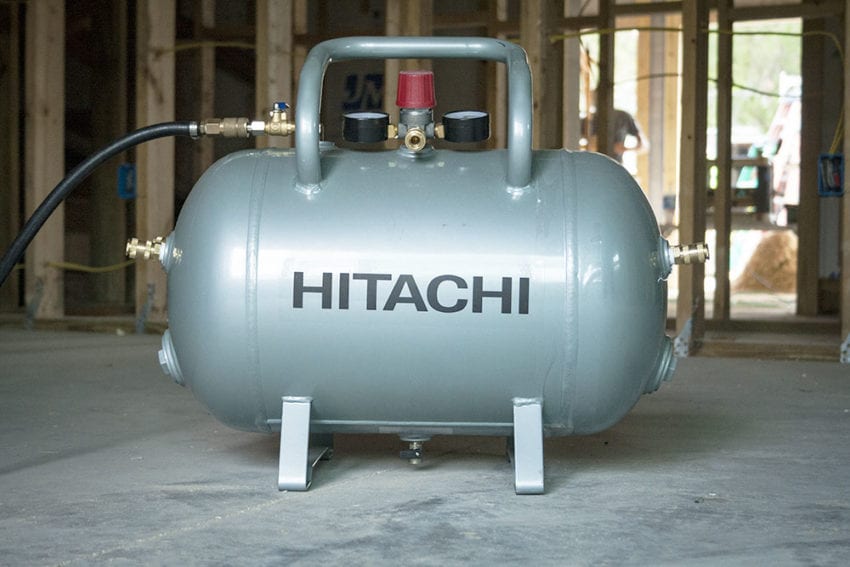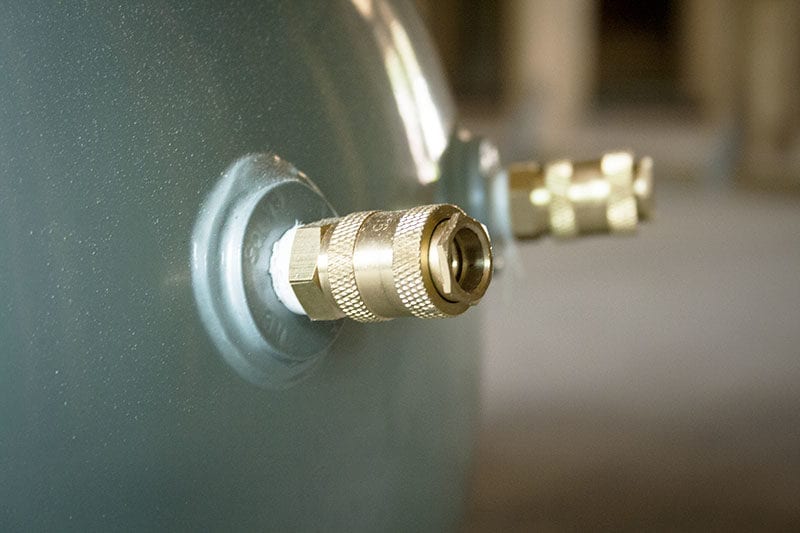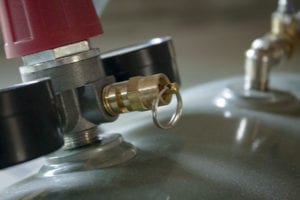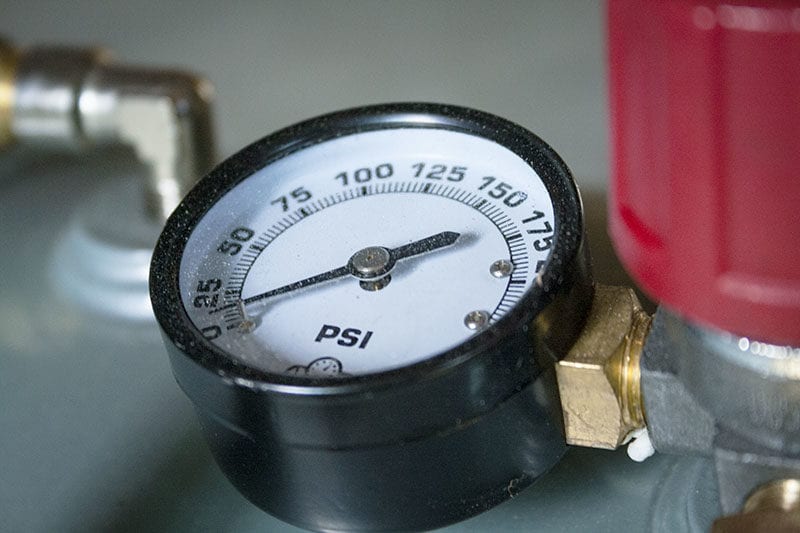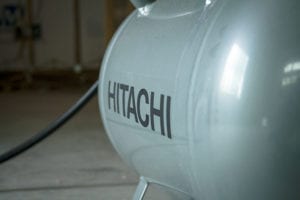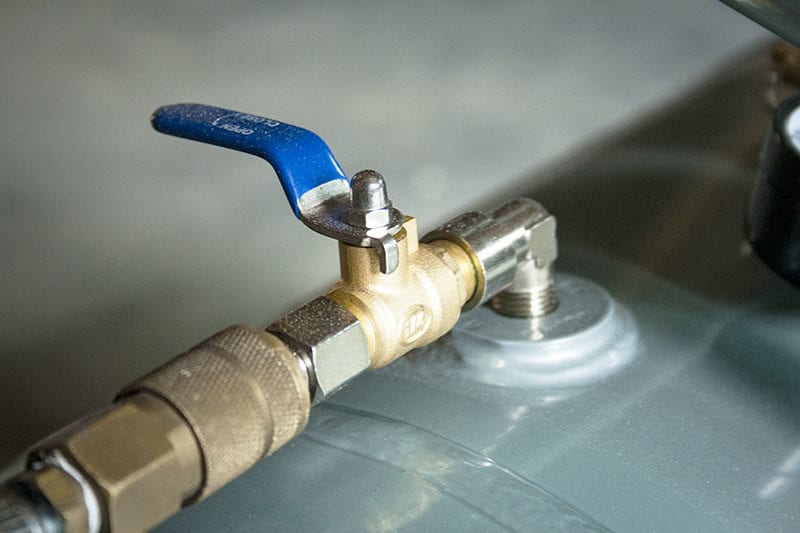I must have hit the Metabo HPT lottery. I’ve not only been able to do several (formerly Hitachi) tool reviews recently, but they’ve all been high-performers. Earlier, I put the Metabo HPT 8-gallon wheelbarrow compressor through its paces and found it to be excellent. Now I have what I hope is an equally excellent companion piece: the Hitachi 10-gallon Reserve Air Tank. With an 8-gallon compressor supplying two couplers that my crew couldn’t outrun, why in the world would I need a reserve tank? Great question. Let’s get to work.
Check out our Best Air Compressors article for our top picks across a variety of applications and uses.
The Case for a Reserve Tank
There are many reasons to choose a reserve tank. Suppose you don’t have access to power, or the electricians need to cut the power for a while. With a reserve air tank, your work doesn’t have to stop. If you need to have several guys framing and another one finishing, the regulator can adjust for the tool requiring lower pressure. If you’ve got an electric compressor, you can use its cord to plug into a power source and use the air hose as your extension cord. Finally, a reserve tank effectively turns smaller compressors (that you can easily outrun) into larger compressors by giving them a 10-gallon head start. You’ll be able to work more efficiently—and with a nicer atmosphere.
First Impressions
The 175 PSI ASME-certified tank has 1/4-inch coupling sockets. Designed to provide consistent, sufficient air pressure, these sockets support up to five pneumatic tools operating 200 feet or more from the compressor. Four of the couplers are 3/8-inch NPT and regulated by the compressor while one 1/4-inch NPT coupler has its own regulator. The 40-pound tank can be taken a lot of places (like a roof!) that the 158-pound compressor cannot. That also means that the compressor’s loud motor can be moved away from the job site for a more pleasant environment—provided you like your coworkers!
The horizontal barrel features a handle that creates a roll-cage design. It protects both the tank and regulator pressure gauges. It also has an input shut-off ball valve, a safety release valve, and a 1/4-inch industrial plug. The tank sits sturdily on two steel legs. All the components look well-built, and the gauges are easy to read. It all adds up to a promising tool that I hoped wasn’t full of hot air!
A Ten Gallon Hat Only Holds Three Quarts
I decided the real test of the Metabo HPT 10-gallon Reserve Air Tank would be to couple it with our old pancake compressor. That seemed a better fit over the Metabo HPT 8-gallon wheelbarrow compressor. We couldn’t outrun the Hitachi compressor with our typical two-guns-at-a-time workflow, but we often outran our pancake compressor. This experiment would really test the mettle of the reserve tank. We let the pancake fill up the reserve tank and got to work. Our experiment, however, was interrupted. Unbeknownst to me, my brother unplugged the compressor to plug in the planer and forgot to plug the compressor back in.
We fired him immediately…just kidding. We used two finish guns for over an hour—just on the pressure from the reserve tank—before we realized what happened. It turned out to be a better experiment than I had planned! It revealed a benefit of the reserve tank that might not be immediately apparent. It’s not uncommon to be working concurrently with electricians who need to cut power to get their work done. Having the reserve tank means that our work doesn’t need to stop when the power does.
The Case for a Reserve Tank
Afterward, we returned to the original test and found that the reserve tank effectively turns a small compressor into a larger compressor by giving it a 10-gallon head start. Using the reserve tank makes it a lot less likely you’ll outrun a small compressor with finish nailers. Of course, you’ll still push the limits of the small compressor and reserve tank with a couple of framing nailers.
The five couplers are really handy. We don’t often have that many pneumatic tools working at once, but we like having the option. The ability to regulate one lower-pressure tool independently of the other four is also a great feature. Perhaps you want to run a finish gun while the other tools drive larger nails. Or, maybe one guy needs to run a sprayer while the others frame. Again, having the option is great.
Pro Tip: Use the bottom drain to remove moisture from the tank every day to prevent rust and extend the life of the tool.
The reserve tank allows you to locate a loud compressor away from the workspace. This makes it easier to communicate, and it generally creates a more pleasant work environment. In fact, the Metabo HPT 10-gallon reserve air tank gives you as much as a 200-foot lead while maintaining consistent pressure to the attached pneumatic tools. Similarly, you can plug an electric compressor into a power pole using its own cord and effectively use your air hose as an extension. What a big benefit!
Metabo HPT 10-gallon Reserve Air Tank Features
- Safety Relief Valve
- Industrial Tank Pressure Gauge and Regulated Pressure Gauge
- Industrial Ball (Shut-Off) Valve on Input
- Four 1/4-inch Quick Connect Couplers with 3/8-inch NPT
- 1/4-inch Quick Connect Coupler (located on Regulator) with 1/4-inch NPT
- 1/4-inch Industrial Plug
- Roll cage design
- Steel tubular handle
- Steel legs
- Industrial ball (shut-off) valve
The Bottom Line
Knowing what I know now, I would have purchased a Metabo HPT 10-gallon reserve air tank a long time ago. It doesn’t hurt that Metabo HPT’s quality and attention to detail make this tank another win in a lengthening line of wins. It’s a 175 PSI ASME-certified tank with five 1/4-inch coupling sockets. Four have 3/8-inch NPT regulated by the compressor and one is a 1/4-inch NPT with its own regulator on the reserve tank. It’s designed to run up to five pneumatic tools 200 feet or more from the compressor. Its components and design are solid. We love the roll cage-shaped handle which protects the regulator. Easy-to-read gauges and steel legs round out what makes this a solid choice. At 40 pounds, it can also go where larger compressors cannot.
There’s not much to talk about with a tank, and Metabo HPT joins other companies that produce well-designed products in this category. The more you use a reserve air tank, the more likely you’ll wonder how you made out without one. Keep that noisy compressor at the edge of the job site instead of in the middle of it.
I can easily recommend the Metabo HPT 10-gallon reserve air tank to you. At $139, you get lots of benefits at a great value—and that’s not a lot of hot air.
Metabo HPT 10-Gal Air Compressor Tank Specifications

